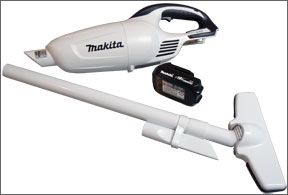
Photos by Doug Logan
288
Crumbs. Sand. Sawdust. Dried mud. Dock dirt. There are always plenty of particulates to clean up on a boat. And while there’s nothing wrong with a dustpan and brush to get the job done—it’s a cheap, time-honored, low-tech solution—a lot of us rely on DC-powered hand vacuums, too. They’re fast and easy to use, can suck dirt out of corners a brush won’t reach, and tend to be better than a dustpan at keeping the captured material enclosed, especially in a breeze. On the downside, they’re noisy, and they require DC juice. In our experience, they also vary in hardiness, vacuuming power, ease of cleaning, and battery quality. So we thought we’d put a range of products through some field and bench tests (see “How We Tested,” facing page) to come up with some practical recommendations.

288
WHAT WE TESTED
We decided to skip the handheld vacuums with integral batteries requiring a charger that plugs into a 110-volt wall socket. Although a lot of boats have inverters that can handle these, it makes more sense to us to either plug directly into a 12-volt receptacle or have a rechargeable hand vac whose battery can power a suite of other hand tools. Many such handheld DC tool systems (in various voltages) are on the market and are widely used by boaters already. Of the different voltages available, 18-volt seems to be a favorite for battery-operated tools these days, and the major players make 18-volt systems, so we stuck with that in narrowing the test field. The test products ranged in price from $16 to $129.
In the hand-vac market, Black & Decker has long been a strong force. We settled on three B&D machines: the SPV1800 Platinum Series, an 18-volt hand vac that runs on the company’s Firestorm batteries; and two plug-in hand vacs, the AV1500 DustBuster and the PAV1200, which has a swiveling nose piece and attachments.
Testers evaluated three products from Ryobi Tools: the P710 Tuff Sucker wet/dry hand vac, the P712 hand vac, and the P3200 wet/dry 2-gallon canister vacuum. All three run on Ryobi’s 18-volt One+ lithium-ion (Li-Ion) battery (slim pack and full size) as well as an 18-volt nickel-cadmium (Ni-Cad) battery.
We also tested a canister vac from Milwaukee Electric Tool, but this one was disguised as a toolbox. The cordless M18 wet/dry vac runs on the same Li-Ion battery as other tools in Milwaukee’s 18-volt suite, but it can also run on the company’s Ni-Cad battery.
We also tested the Makita BCL180W, a Li-Ion battery-powered hand vac with a stand-up attachment, and an interesting 18-volt hybrid—part hand vac, part canister vac—from DeWalt.
Rounding out the test field was an inexpensive plug-in canister vac from RoadPro, the maker of many a DC-powered product.
WHAT WE FOUND
If you can find a reason to have a battery-powered hand vacuum, especially as part of a suite of similar onboard tools, then that’s the way to go. The advantages of the 12-volt plug-in types—inexpensive, no need for replacement batteries, and plenty of available amp-hours—might hold stronger appeal for the long-term cruiser. But in actual use, the conveniences of an untethered vac were obvious.
Another general finding: There was little difference between these vacs in terms of power, battery longevity, or even noise (although the DeWalt is a screamer). The things that made more of a difference had to do with overall convenience, attachment storage, ergonomics, price, and, of course, integration with other tools. If you have a bunch of 18-volt Black & Decker tools, you would naturally think twice about buying a vac, battery, and charger outside the family.
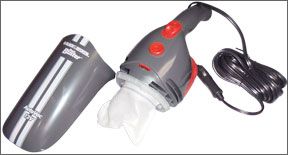
288
BLACK & DECKER
The SPV1800 vacuum we tested has been part of our toolset for a couple of years; it had seen about a half-hour of accumulated use before this testing. Testers used a brand-new battery and filter for this evaluation. While the vac did fine in the testing, Black & Decker 18-volt Firestorm Ni-Cad batteries are being outpaced by the competition. They are strong and reliable, but they come standard with “dumb” chargers. The user has to remember not to leave batteries charging for longer than the prescribed time, or their lifespan can be drastically shortened. It’s an expensive mistake—one we’ve made more than once. If you use a dumb charger, set it up to work through a timer. A multi-voltage charger with maintenance mode is listed on the Black & Decker website, but it is sold separately.
The less expensive Black & Decker AV1500 plug-in costs only $16, and it does a good job of vacuuming. However, the exhaust exits the side ports so forcefully that if you’re trying to vacuum a fine particulate—stove ash or fine sawdust, for example—the exhaust tends to blow the target all over the place.
The more exotic B&D PAV1200W plug-in is an interesting and effective vacuum with multiple bonus features. With a pivoting nose, it can easily get into some places that are hard or impossible to reach with a fixed nose, and the proboscis can fold under the vacuum body for efficient stowage. There’s no side-blow, and the debris reservoir is side-opening with a filter-scrubber that is twisted from the outside. The power cord can be neatly wound up, there are several good attachments, and all can be stowed in a bag.
Bottom line: The feature-laden PAV1200W gets testers’ pick for a plug-in vacuum.
Road-Pro
We included RoadPro’s Model RPSC870 one-gallon wet-dry vac because we wanted to compare it to the Milwaukee and Ryobi battery-powered models. The RoadPro is a simple, inexpensive machine that comes with standard automotive attachments and a spare filter sock.
When we first used it to vacuum sawdust, we did not have the filter sock snugged up tightly enough over the suction intake cage. It took a fair amount of vacuuming to correct that mistake.
The RoadPro’s performance was on a par with the other canister vacuums, but it seems better suited for automotive uses than marine uses.
Bottom line: If you need a small, plug-in canister vac, the RoadPro is worth considering; however, testers preferred the larger, cordless Milwaukee and Ryobi wet/dry vacs.
DeWalt
DeWalt is a sibling company to Black & Decker (and Stanley Tools), but the trade name has always carried its own weight. The DeWalt DC515K wet/dry handheld vac we tested features an intake hose that can be pulled out and wielded independently, and its wet capacity is a half-gallon.
Its dry vacuuming performance was on a par with all the other machines, and it seemed a bit faster than the other wet vacs in picking up the liter of water. The DeWalt also had the easiest waste reservoir to empty, and we liked its clever design. Its downside was that it was the loudest of all the vacs, with a particularly high-pitched shriek, and it was a bit ungainly in the hand.
Bottom line: A good performer, the DeWalt lost points on ergonomics and noise.
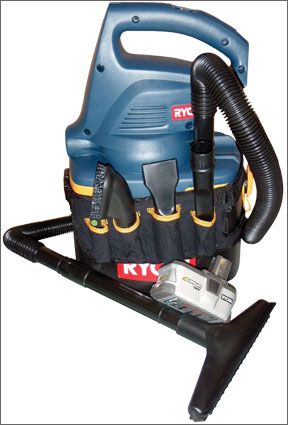
288
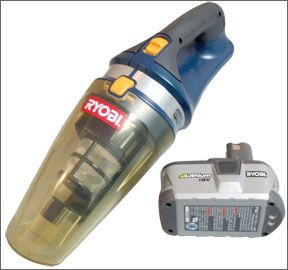
288
Ryobi
Ryobi has a strong sales and marketing arm, and a good industrial design team. We were prepared to find that the company’s vacs would not live up to their looks or their strong presence in the retail world. But the three Ryobi vacs we tested all did well.
Model P710, rated as wet/dry, is now sold only through Home Depot online, while the replacement, Model P712 is not rated wet/dry but is sold in all outlets. The P712 has improved storage for nose attachments, and seems to have slightly improved suction. It covered all the basics very well and was one of the test’s top performers.
Ryobi’s Model P3200 two-gallon canister vac also performed well with the Li-Ion battery. It comes with a nylon tool belt that buckles around the body and holds attachments—a novel idea, but a bit of a pain when it comes to switching out attachments and removing the top part of the vac from the tank reservoir.
We were impressed with the P3200’s blower function, and the whole unit is ergonomic. However, the same shape makes it more difficult to stow, as nothing can be stacked on it.
Bottom line: The Ryobi P712 gets our pick as an affordable hand vac, while the P3200 would be best used for dockside projects. These would be doubly good picks if you already own one of the 40 interchangeable tools in Ryobi’s 18-volt suite.

288
Milwaukee
Milwaukee Electric Tool’s M18 wet/dry canister vac is shaped like a standard toolbox—one sturdy enough to be sat upon or stood on. The bottom is a two-gallon reservoir, and the top opens to reveal attachments and battery space. The vac will take either Milwaukee’s Ni-Cad or Li-Ion batteries. Its detachable hose, which is stored on one end of the box, is more heavy duty than the hoses on the RoadPro, DeWalt, or Ryobi canister vacs, and can be plugged into one side of the “toolbox” for vacuuming or the other for blowing.
The Milwaukee vac performed on par with all the others, and although the Li-Ion battery cutoff circuitry tripped sooner than its competitors, that’s not a strike against Milwaukee.
Bottom line: If the Milwaukee vac, battery, and charger combination were closer to the price of the Ryobi canister combo, it would be easier to give the nod to Milwaukee for its hardy, no-nonsense design and attachment stowage. As things are, though, we’ll call it a draw with both units Recommended.
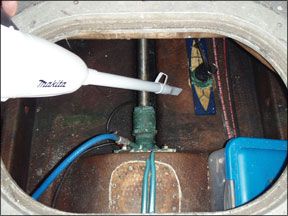
288

288
Makita
Makita has long been known for making quality tools, and its BCL 180 handheld vac upholds the company’s reputation. It was the quietest of all the vacuums tested, with no loss of performance. The filter system, a simple cloth bag inside a plastic mesh basket, was one of the easiest to clean.
The vacuum comes with only two attachments, a standard carpet-cleaning head and a crevice tool. However, it also comes with a simple straight extension that allows the user to vacuum standing up. This small bonus feature made a world of difference to our testers, not only when vacuuming out bilge spaces but also just when vacuuming sawdust off the deck. It’s nice not to have to kneel down all the time. The Makita reminded us that there’s far too much crawling around on boats.
Bottom line: Let us stand, now, like advanced primates! The Makita gets PS’s Recommendation.
Conclusion
Selecting top picks from a field of 10 handheld vacuums was more challenging than we expected. With little variation in performance and battery capacity, it came down to ergonomics and features. In the end, we reached some solid recommendations for those who are ready to leave the broom and dustpan at the dock.
The Milwaukee and Ryobi canister vacs earned testers’ favor in the wet/dry group, while the Ryobi P712 and Makita BCL180W topped the cordless roster. For those undeterred by the limitations of a corded vacuum, the favorite in this test was the Black & Decker PAV1200W.



































